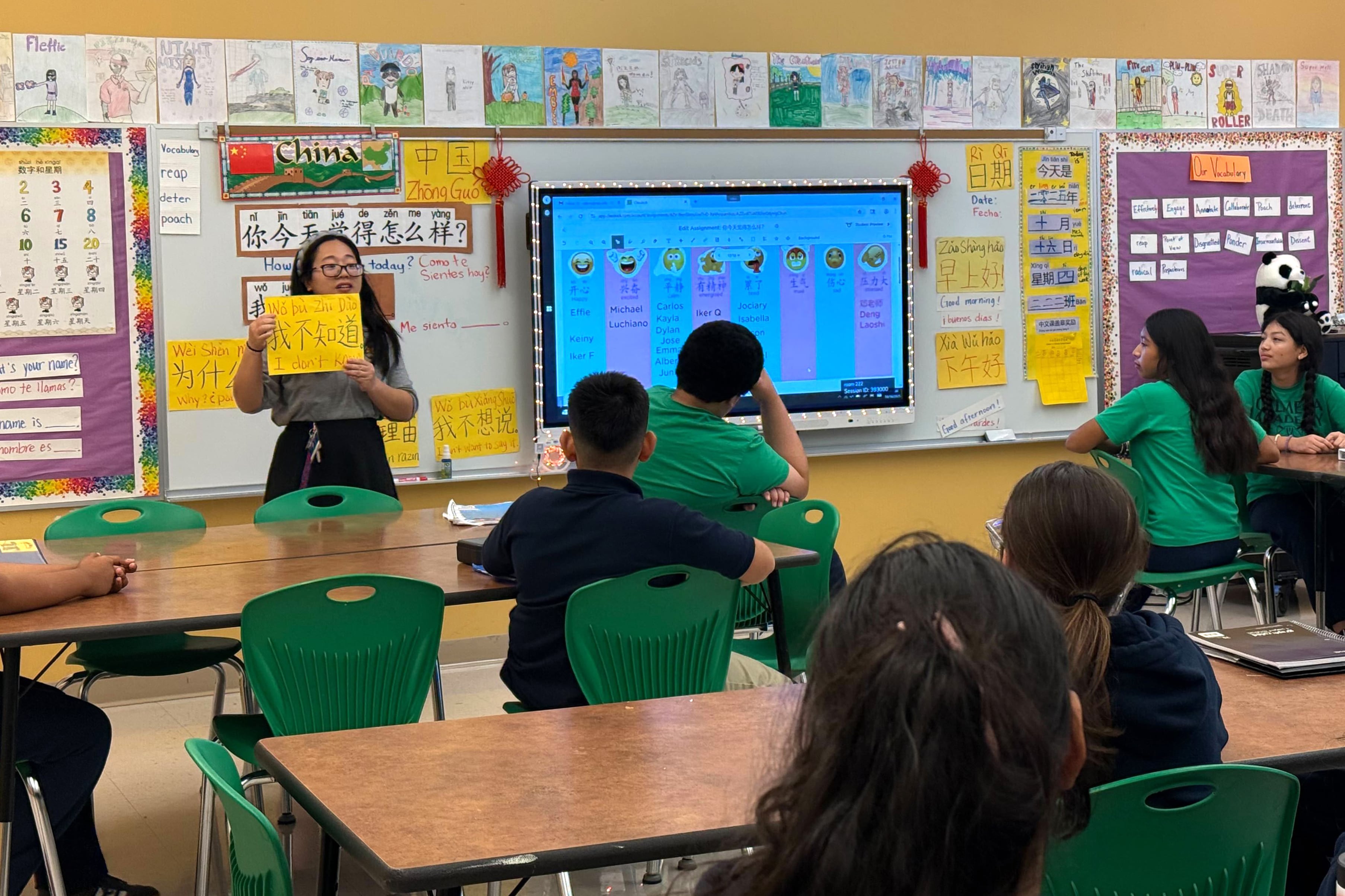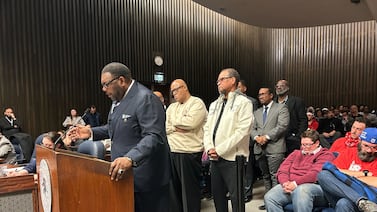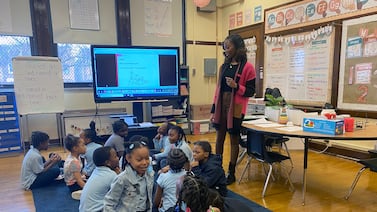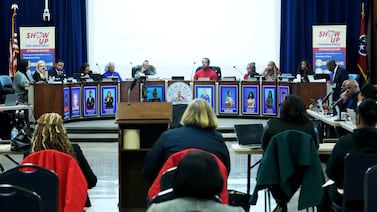Sign up for Chalkbeat Chicago’s free daily newsletter to keep up with the latest news on Chicago Public Schools.
In Room 222 at Calmeca Academy of Fine Arts in Chicago’s Brighton Park neighborhood, students in a world language class on Thursday morning were learning Mandarin.
Some raised their hands when their teacher asked in Mandarin if they were stressed as several Chicago Public Schools officials and journalists observed their lesson, drawing a laugh.
In other Calmeca classrooms, kids were learning different subjects in both Spanish and English as part of the school’s dual language program.
On Thursday, CPS officials visited Calmeca — where 97% of students are Hispanic — to show off what different language programs can look like as they announced three new dual language programs and three more world language programs at schools across the city. District leaders said the expansion is part of a long-term goal to provide more language options for students and is also part of CPS’ new contract with the Chicago Teachers Union.
In a press release, district officials said they will provide “ongoing support” to the newly minted schools, including professional development. Additionally, the district’s funding formula provides a dual language coordinator to schools with such programs.
“This work empowers the way students see themselves,” said interim CPS CEO Macquline King during the event Thursday announcing the expansion. “It builds their confidence and their ability to build their literacy and fluency skills in multiple languages.”
The new dual language programs will be at Henry D. Lloyd Elementary School in Belmont Cragin, Little Village Elementary School in Little Village, and Edward E. Sadlowski Elementary School in the East Side neighborhood. World language programs will open at Edgar Allen Poe Classical Elementary School in Pullman, Louis Nettelhorst Elementary School in Lakeview, and George B. Swift Elementary Specialty School in Edgewater.
CPS has 43 other dual language programs and about 240 world language programs, according to a press release from the district.
Through its world language programs, CPS schools teach students American Sign Language, Arabic, Chinese, French, German, Italian, Japanese, Korean, Latin, Polish, and Spanish, according to its website.
In dual language classes, students learn in both English and one other language. Students learning English as a new language can choose to enroll in dual language programs and learn subjects in English in addition to their native language, such as Spanish, in order to meet their needs for special language instruction they are legally entitled to. But unlike other programs specifically for English learners, dual language courses can be offered to native English speakers, too.
Many experts view dual language programming as a gold standard of teaching English to those learning it as a new language. Last March, as the city saw an influx of migrant families, then-CPS CEO Pedro Martinez said the district had planned to “hit the gas pedal” on opening new dual language programs.
CPS has historically struggled to serve students learning English as a new language in accordance with state law, which requires bilingual programming at schools when 20 or more English learners who speak the same native language enroll. Part of that challenge has been finding bilingual certified teachers, a teacher shortage area in districts across the country. The challenge grew as migrant students enrolled and began settling down in communities with schools that historically served native English speakers.
CPS officials evaluated schools interested in launching new dual and world language programs by reviewing “detailed proposals” that outlined the school’s plans and what kind of resources they needed, according to the district press release.
Laurel Salgado, principal of Lloyd Elementary School, said his school had unsuccessfully applied twice, before the pandemic, to open a dual language program. He is not sure what changed after it applied this summer, but school officials were “so excited” to be selected, he said.
Salgado said the process involves CPS interviewing school staff and families and visiting the school to make sure “to see if we have the manpower [and] the ability to become dual language.”
He said most of the school’s teachers have the right credentials to teach Spanish dual language classes. This school year, Salgado said he and his staff are in an “incubation period” where they’ll plan out the program, which will officially be offered to pre-K and kindergarten students next year. They’re meeting regularly and setting up visits to more established dual language schools.
“We’re going to be looking at different models at different schools that are dual language – some schools that are similar to our demographics – and this is so we can learn from them,” Salgado said. CPS has provided a dual language coordinator to the school, Salgado said.
At Poe, Principal Eric Dockery said all students are already getting Spanish lessons two hours each week from a new Spanish teacher who also teaches the language before and after school.
Similar to Calmeca, many of Poe’s students are being exposed to languages they’re not familiar with. In addition to mastering another language, Dockery said he wants his students, 87% of whom are Black, to “appreciate different cultures even though we don’t have a large Spanish-speaking population in our school right now, but we’re hoping that can change.”
Reema Amin is a reporter covering Chicago Public Schools. Contact Reema at ramin@chalkbeat.org.





